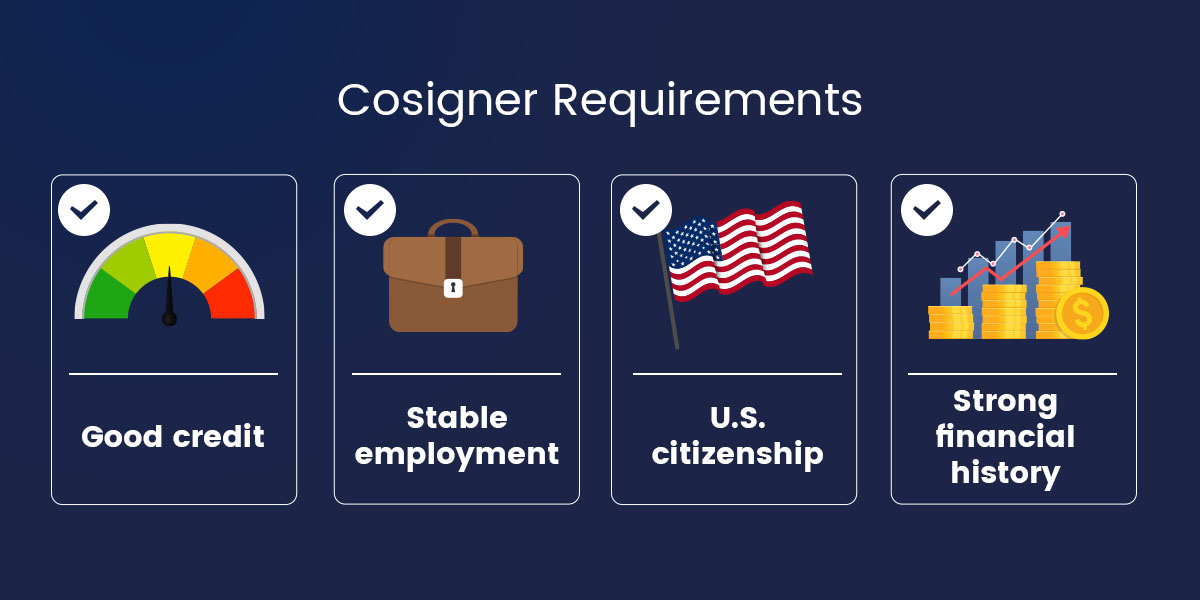
Cosigning a personal loan is a generous way to help someone qualify for financing they cannot get on their own. It shows trust and support, but also means taking on legal and financial responsibility for the debt. Cosigning a loan for a family member or friend can help them secure financing, but it's essential to have clear, honest conversations and a backup plan in case things go off track. Before agreeing to cosign, ensure that both parties understand the potential benefits and risks.
What Is a Cosigner?
A cosigner is someone who agrees to take full responsibility for repaying a loan if the primary borrower cannot. Their role is to boost the borrower's application by adding their stronger credit history or income to help the loan get approved. Typical scenarios requiring a cosigner include:
- The borrower has a poor or limited credit history.
- The borrower has a low income or a high debt-to-income (DTI) ratio.
- The loan type or lender requires a cosigner for added security.
It is important to differentiate cosigners from co-borrowers. A cosigner generally does not benefit directly from the loan — they are just helping someone else qualify. A co-borrower, conversely, shares both the responsibility and ownership. For example, if two people apply for a car loan together and both drive the car, they are co-borrowers.
What Does It Mean to Cosign for a Loan?
Lenders view cosigners as a safety net. A strong cosigner can lower the lender's risk, which can lead to better terms, like lower interest rates, for the borrower. Cosigners should be cautious — missed payments affect their credit, and they could be asked to repay the full amount. If the loan goes into default, the cosigner could also be contacted by collectors or even sued.
Cosigner Requirements

Lenders set clear cosigner requirements for personal loans, relying on them to repay the loan if the primary borrower is unable to do so. In most cases, cosigners need to meet stricter criteria than the borrower. A cosigner with bad credit but good income will not meet lender requirements. Here is what they typically look for:
- Good credit: Most lenders prefer a good credit score, which is considered 670 or higher, though some may ask for one over 700, depending on the type of loan.
- Stable employment: Cosigners usually need a steady job and proof of sufficient income to cover the loan if necessary.
- U.S. citizenship: Lenders often require that cosigners be U.S. citizens or permanent residents with a valid Social Security number.
- Strong financial history: Lenders look for a track record of on-time payments and low debt levels. A cosigner with missed payments or recent bankruptcies may not qualify.
To prove they meet these standards, cosigners will need to provide:
- Proof of residence
- A government-issued ID
- Their Social Security number
- Pay stubs or other proof of income
- Bank statements to verify their assets and savings
How Cosigning a Loan Impacts Your Credit Score
When someone cosigns a loan, they legally take on full responsibility. This obligation shows up on the cosigner's credit reports and affects key components of their credit score:
- Payment history: Every payment, made or missed, affects the cosigner's credit score. Even one missed payment can drop the cosigner's credit score, damage that can potentially last for years.
- Credit utilization: Credit utilization reflects how much debt is carried versus available credit. Higher utilization adds to the total debt while lowering credit capacity, making the cosigner look riskier to lenders.
- Credit history length: The account age matters too. If the cosigned loan is new, it may slightly reduce the average account age, which can temporarily lower the cosigner's score.
- New credit: Cosigning counts as a new credit inquiry and a new account on the cosigner's report. A hard inquiry may cause a small, short-term drop and can lower the average account age.
- Credit mix: Having a mix of credit types, like mortgages, auto loans, and credit cards, can improve a credit score. A cosigned loan can help diversify the cosigner's profile.
- DTI: DTI compares monthly debt payments as a percentage of monthly income. Lenders generally assess borrowers with a lower DTI as more capable of repaying new loans. While DTI doesn't affect your credit score, it's still a critical component of creditworthiness.
Benefits of Cosigning a Loan

Cosigning a loan can help someone move forward financially, especially if they are struggling with poor or limited credit. While it is a serious commitment, there are several meaningful benefits to both parties that include emotional rewards, financial opportunities, and strengthened relationships.
How Cosigning Helps the Borrower
Borrowers with low credit scores often face rejection. A cosigner with strong credit can help them get approved for loans they would otherwise be denied, like auto loans, student loans, or personal loans.
Adding a cosigner can also unlock lower interest rates, reduced fees, or higher loan amounts. Since the loan is typically reported to the credit bureaus under both names, a primary borrower who makes on-time payments can build their credit history and boost their credit score. This boost could allow them to qualify on their own in the future.
How Cosigning May Help the Cosigner
Cosigning primarily involves the cosigner's credit profile and financial trust. If all goes well and payments are made on time, the cosigner will not pay out of pocket. If the lender reports on all borrowers, and payments are made on time, the cosigner's credit report may also benefit. However, cosigners should always be prepared for the risk of the borrower missing payments.
In many cases, cosigning is a gesture of trust and support. It is a way to help a child go to college, assist a partner with rebuilding credit, or help a friend get reliable transportation to work. When handled responsibly, it can build stronger bonds and a shared sense of achievement.
Emotional and Relational Positives
Cosigning is more than a financial agreement — it is often an emotional one. When a cosigner helps someone qualify for a loan, they show belief in the borrower's ability to succeed. That can be incredibly empowering for the borrower, especially if they have faced past financial setbacks or rejections.
Many parents cosign for their children's first student loan or car, seeing it as an investment in their future. Friends or partners might do so during a time of rebuilding or transition. In these cases, cosigning can symbolize trust, encouragement, and a shared goal.
Additional Considerations
Despite the benefits, the cosigner should always approach the decision with clear communication and boundaries:
- Set expectations around how payments will be made.
- Discuss backup plans in case of job loss or financial hardship.
- Consider checking in monthly or getting access to payment alerts.
Disadvantages of Cosigning a Loan
While cosigning can be a generous act, it has serious consequences. Cosigners take on full financial liability, and it is crucial to understand exactly what that means before signing on the dotted line.
Full Legal and Financial Liability
With cosigning, the cosigner is equally responsible for the full debt. If the primary borrower misses a payment, the cosigner is legally required to pay, even if they never received the money, used the service, or benefited from the loan:
- Late payments affect the cosigner's credit score just as much as the borrower's.
- If the borrower defaults, the lender can pursue the cosigner for the entire remaining balance, plus late fees, interest, and collection costs.
- The lender can sue the cosigner, garnish their wages, or place a lien on their assets, depending on state laws.
Reduced Borrowing Power
Cosigning a loan increases the cosigner's debt load in the eyes of other lenders. This also increases their DTI, making it harder to qualify for loans or credit cards. It is also important to consider credit utilization, especially if the cosigned loan is a revolving line of credit, like a credit card. A high balance can negatively affect the credit score, which in turn impacts interest rates and approval chances for future loans.
Disadvantages for the Cogsignee
For the cosignee or primary borrower, having a cosigner comes with pressure. Their actions directly affect someone else's credit and finances. If they struggle with payments, they risk damaging their own credit and their relationship with the cosigner. That stress can linger, especially in families or close friendships.
What to Consider When Deciding to Cosign a Loan
Before you cosign a personal loan, it is crucial to weigh the risks. The cosigners must be aware of the potential impact on their credit score, whether they can take on the financial strain if the borrower falls behind on payments, and whether they can handle the legal responsibility.
Have Open, Honest Communication
Before cosigning, have a clear conversation with the borrower to ensure both parties understand what is expected and keep the lines of communication open by discussing:
- Their income and ability to repay the loan.
- What the cosigners can do if the borrower has trouble making payments.
- How and when to communicate about the loan.
Stay Involved After Signing
The cosigner can ask the lender for access to the account to monitor payment activity, receive alerts or statements, and be notified of any missed or late payments. Setting up a shared calendar reminder or periodic check-ins with the borrower can help both parties stay on track.
Talk to a Professional
Cosigning a loan is a personal decision that deserves careful thought. It should only be done with clear eyes, honest communication, and a solid backup plan.
Before committing, the cosigner can consider speaking to a financial advisor or attorney. These professionals can help explain the full implications of unique circumstances and whether it makes sense for the cosigner's situation.
Step-by-Step Process of Cosigning a Loan

Once the cosigner is assured they can take on the potential financial responsibility and has a discussion with the borrower to get on the same page, the loan process starts. Here are the steps that follow:
- Step 1: Understand the loan details, including the interest rate, fees, monthly repayment amount, and the loan term. The cosigner should ask the lender questions to ensure they understand what they are agreeing to.
- Step 2: The cosigner goes through the same application process as the borrower. They will need to provide personal information, proof of income, employment details, and a credit history.
- Step 3: If approved, the cosigner signs the loan agreement along with the borrower, legally binding both to the loan terms.
Conditions for Being Released as a Cosigner
Cosigner release clauses can offer some peace of mind. This feature in some loan agreements lets the cosigner off the hook after the borrower meets certain requirements, protecting cosigners from being tied to a loan for the entire repayment term. They allow the cosigner to be removed from the loan following specific conditions, but getting released is not always easy.
Typical Requirements for Release
Most lenders will only release a cosigner following an application for it. Ask about the option of cosigner release before signing any documents. Common conditions include:
- On-time payments: The borrower makes several consecutive, on-time monthly payments.
- Credit check: The borrower must prove they can handle the loan on their own, often by passing a credit and income review.
- Formal request: The borrower or cosigner must submit a written request or complete a release application with the lender.
Alternative Release Options
If the cosigner release is unavailable or is not approved, there are alternative options to the cosigner release:
- Loan refinancing: The borrower can apply for a new loan in their name only and use it to pay off the original loan.
- Debt payoff: If possible, paying off the loan early removes the obligation entirely.
- Transfer to another cosigner: It is rare, but sometimes borrowers are allowed to transfer their loan to a different cosigner. This depends on the lender.
Why Trust Us
Founded in 1968, Atlas Credit has become the go-to responsible and reputable personal lender with over 50 locations in Oklahoma and Texas, as well as a reliable online lending service. We have decades of experience providing personalized loans, including cosigner loans, to people with diverse financial circumstances.
Our employees have high levels of expertise in the financial industry and a degree of professionalism that our customers appreciate deeply. We are also committed to helping our customers understand their finances before they receive their loan. This part of our service includes income, debt, and expense analysis with budgeting to empower borrowers.
Get Personal Loans With a Cosigner From Atlas Credit
Cosigning a loan can be a life-changing gesture for someone with poor credit, offering them access to financial tools, better loan terms, and a path to build their credit. For the cosigner, the rewards are less about money and more about trust, support, and the satisfaction of helping someone get back on their feet. It is not for everyone, but with mutual respect and responsibility, it can be a powerful step forward for both parties.
At Atlas Credit, we consider more than your credit score, and you can get a cosigner to help you get a personal loan. We make your personal loan application simple and offer quick turnaround times. You can also get more support with Atlas Protect, with features like real-time credit alerts.
Fill out our loan form today for a personal loan with us.



